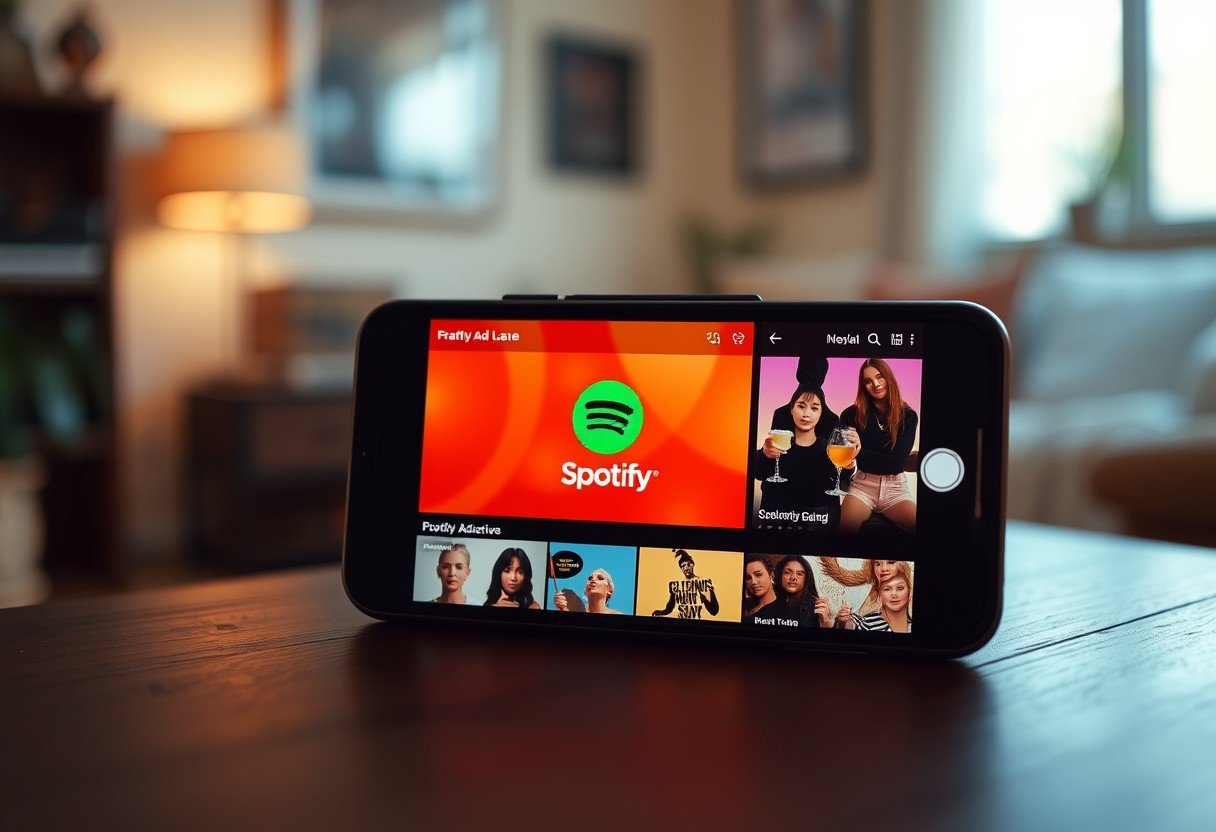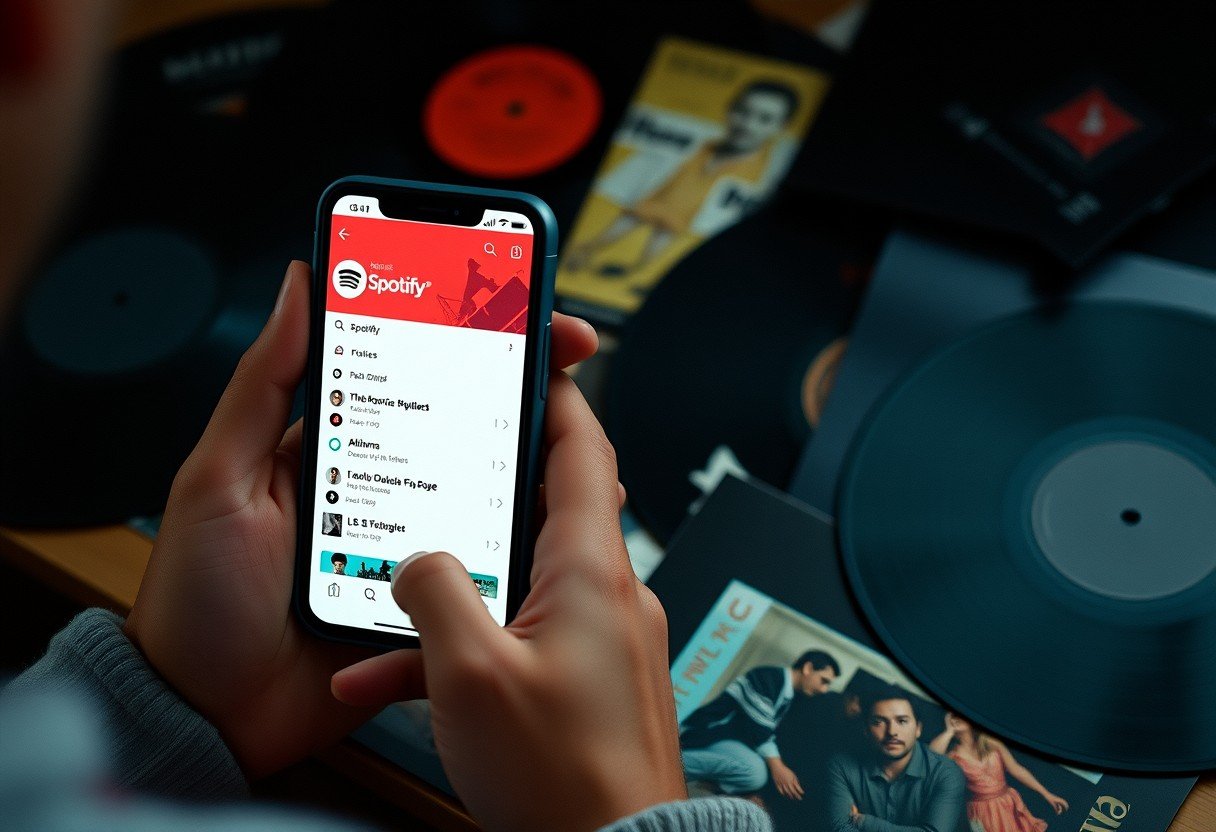Most Spotify users have likely noticed the frequent ads interrupting their music experience, leading to questions about their prevalence. Understanding why Spotify utilizes so many advertisements is crucial for enhancing your listening experience and making informed choices about subscription plans. In this blog post, we’ll research into the reasons behind Spotify’s advertising strategy, how it impacts user experience, and what options you have to minimize these interruptions. Whether you’re a free user or considering a premium subscription, you’ll find valuable insights to help navigate the Spotify landscape.
Key Takeaways:
- Ad-Supported Model: Spotify offers a free tier that generates revenue through advertisements, which is vital for maintaining its operations and funding music licensing costs.
- User Base: Having a large number of free users means more ads, as Spotify monetizes these listeners to subsidize costs and support the platform.
- Targeted Advertising: Spotify uses data-driven approaches to deliver targeted ads, which increases their appeal and effectiveness, benefiting advertisers and contributing to more frequent ad placements.
- Subscription Promotion: The presence of ads serves as a promotional strategy to encourage free users to upgrade to premium subscriptions for an ad-free experience.
- Content Diversity: Ad revenue is crucial for supporting a diverse range of content on the platform, allowing Spotify to invest in podcasts and unique playlists.
Understanding Spotify’s Business Model
The success of Spotify can be attributed to its innovative business model that combines both freemium and premium subscription options. This approach allows you to experience the platform for free, albeit with ads, while enticing you to upgrade for an ad-free experience and enhanced features. By offering a tiered service, Spotify effectively reaches a wider audience, accommodating different preferences and budgets, which ultimately fuels its growth.
Freemium vs. Premium
To get you started, Spotify offers a freemium model that lets you access its extensive music library at no cost. While the free version is ad-supported, the premium subscription removes ads entirely and provides additional features like offline listening and superior audio quality. This strategic model encourages you to consider upgrading for an enhanced experience.
Revenue Sources
For Spotify, revenue is generated through a combination of advertising and premium subscriptions. The ads you hear while using the free version create a steady income stream, while premium subscriptions provide higher revenue per user. This dual approach enables Spotify to invest in content, technology, and artist partnerships.
Model diversification is key to Spotify’s financial strategy. By leveraging both advertising sales and subscription fees, you benefit from a vast library of music and personalized playlists. The ads you encounter contribute to funding the service, allowing Spotify to invest in securing licensing agreements and creating innovative features. This ensures that both free and premium users have access to quality content while supporting artists in the long run.
The Role of Advertising in Streaming Services
One of the key components of streaming services like Spotify is advertising, which plays a crucial role in generating revenue. While subscription models offer ad-free experiences, the ad-supported tier allows users to access music without a fee. This model attracts a wider audience and enables Spotify to monetize its user base. Understanding the implications of advertising within streaming services will help you appreciate the balance between accessibility and revenue generation.
Ad-Supported Revenue
To fully grasp Spotify’s ad strategy, it’s imperative to recognize that ad-supported revenue is a vital source of income. Spotify monetizes its free users by providing advertisers an opportunity to reach a large audience. This not only sustains the platform but also allows you to enjoy music without paying. Ultimately, this model creates a win-win situation for both users and advertisers.
Types of Ads on Spotify
The types of ads you encounter on Spotify vary significantly, catering to different advertising strategies. These ads can enhance your experience while also promoting various brands. Here’s a breakdown of the different ad formats:
| Type of Ad | Description |
|---|---|
| Audio Ads | Short audio commercials played between songs. |
| Display Ads | Visual ads that appear on the app interface. |
| Sponsored Sessions | Ad campaigns that allow users to listen ad-free for 30 minutes. |
| Video Ads | Short video ads that can be watched in the app. |
| Podcast Sponsorships | Ads integrated within podcast episodes. |
A variety of ad formats allow you to experience different engagements with brands, enhancing your music journey on Spotify. Here’s a deeper investigate each type:
- Audio Ads: Engaging short messages providing imperative information about brands.
- Display Ads: Visual showcases linking directly to products or services.
- Sponsored Sessions: Rewarding users with ad-free listening in exchange for engaging with ads.
- Video Ads: Captivating visual content you can choose to view.
- Podcast Sponsorships: Intriguing narratives woven into the dialogue of your favorite shows.
Thou can see how each ad type serves a specific purpose, contributing to the broader advertising ecosystem that supports Spotify’s free tier.
User Experience vs. Ad Frequency
Unlike many other streaming platforms, Spotify offers a free tier that comes with ads, which can disrupt your listening experience. You might notice that while ads are important for Spotify’s revenue, they can also take away from the immersion of your favorite playlists or podcasts. Striking a balance between monetization and user satisfaction is crucial, as too many ads can lead to frustration and potential cancellations.
Balancing Act
To maintain a thriving listener base while generating revenue, Spotify must carefully manage the frequency of ads. Your listening experience hinges on this delicate balance, as excessive advertising can drive you to consider premium subscriptions or alternative platforms. Spotify is constantly analyzing usage data to optimize ad placements without overwhelming you.
Listener Feedback
Any successful platform must adapt to user preferences, and Spotify actively seeks listener feedback to refine its advertising strategy. You can often find surveys or feedback options that allow you to express your thoughts on ad frequency and relevance, thereby influencing future changes.
Listener feedback plays a critical role in shaping Spotify’s approach to advertising. By actively soliciting your opinions, they can gather invaluable insights into what you find acceptable or intrusive. This ongoing dialogue allows Spotify to adjust its ad strategy, ensuring that they provide a more tailored experience that resonates with you, while still meeting their revenue goals. Your voice matters, influencing everything from ad content to frequency, ultimately enhancing your overall experience on the platform.
The Impact of Ads on User Retention
To understand Spotify’s ad strategy, it’s crucial to recognize how ads influence user retention. Frequent interruptions from ads can leave you frustrated, prompting a potential shift to rival platforms. However, Spotify carefully calibrates its ad frequency to balance monetization goals while retaining its user base. This delicate balance is crucial, as happy users are more likely to stick around, ensuring Spotify’s continued growth and profitability.
Churn Rate Considerations
One of the primary concerns for Spotify is the churn rate, or the percentage of users who discontinue their subscriptions. High churn rates can signal dissatisfaction with the listening experience, particularly if you find ads excessive. As a result, Spotify continually analyzes user feedback and behavior to minimize the impact of ads while maximizing engagement.
Conversion Strategies
Churn can significantly affect your service experience, so Spotify implements various conversion strategies to retain and grow its user base. These strategies often include targeted promotions for premium subscriptions, showcasing the benefits of an ad-free experience, and personalized content to enhance user engagement.
Impactful conversion strategies require Spotify to focus on personalized marketing techniques. By analyzing your listening habits, Spotify can offer tailored promotions, enticing you to upgrade to premium services. The goal is to demonstrate the value of a subscription, highlighting the seamless experience free from interruptions, which directly addresses concerns about ads, thereby fostering loyalty and reducing churn.
Comparing Spotify’s Ad Strategy to Competitors
Not all music streaming services utilize ads in the same way. Spotify’s strategy is distinctive, offering a freemium model that contrasts with other platforms. Here’s a comparison of Spotify’s ad approach to its competitors:
| Platform | Ad Strategy |
|---|---|
| Spotify | Freemium model with targeted ads |
| Pandora | Ad-supported and subscription tiers |
| Apple Music | Ad-free subscription model only |
Pandora and Apple Music
One significant difference between Spotify and its competitors like Pandora and Apple Music is their approach to ads. Pandora provides a similar freemium model but has a more extensive ad experience, while Apple Music opts for an entirely ad-free subscription experience, pushing users towards premium memberships.
Emerging Platforms
Platforms like YouTube Music and Amazon Music have also entered the market with innovative ad strategies. This competition forces Spotify to continuously adapt its ad offerings, balancing user experience with monetization needs. YouTube Music uses video ads and offers an ad-free tier, while Amazon Music similarly combines ads in its free service. This variety reinforces the importance of understanding how ads can influence your listening experience on different platforms.

Future of Advertising on Spotify
Once again, the landscape of advertising on Spotify is poised for transformation. As the platform continues to innovate and evolve, you can expect new ad formats and targeting options that enhance the user experience while simultaneously increasing revenue opportunities for advertisers. This dual focus will likely lead to more engaging and personalized advertisements, bridging the gap between commercial content and the premium listening experience you enjoy.
Trends in Digital Advertising
Digital advertising is rapidly changing, with a significant shift towards more interactive and immersive content. As Spotify embraces technologies like augmented reality and programmatic buying, you can anticipate an advertising experience that not only captures your attention but also encourages deeper engagement with brands you love.
Potential Changes in User Experience
With the evolving advertising landscape, you may experience new features designed to enhance your listening journey. From customizable ad settings to more relevant ad placements, Spotify aims to create a balance between monetization and user satisfaction, ensuring that ads complement, rather than disrupt, your musical experience.
Experience is crucial when it comes to maintaining your engagement with Spotify. As the platform explores various ways to integrate ads seamlessly into your listening habits, you might see options that allow for ad preferences tailored specifically to your tastes. This not only minimizes interruptions but also enriches your overall experience by presenting advertisements that are more aligned with your interests, ultimately keeping the joy of music at the forefront.
Conclusion
Summing up, you may notice that Spotify has many ads because it operates on a freemium model that relies on advertising to sustain its free service. This allows users like you to access a vast library of music without paying, while advertisers seek to reach your attention with targeted messages. If you prefer an ad-free experience, you might consider upgrading to Spotify Premium, which provides additional features and uninterrupted listening.
FAQ
Q: Why does Spotify have ads on its free version?
A: Spotify offers a free version to attract users who may not be ready to pay for a subscription. The ad-supported model allows Spotify to generate revenue from advertisers. This lets users access the platform at no cost, while advertisers can reach a large audience, which helps Spotify sustain its operations and invest in new features.
Q: How do Spotify ads affect the listening experience?
A: Ads can interrupt the flow of music while using the free version, which some users find disruptive. Spotify typically plays ads between songs or at designated intervals, aiming to balance music enjoyment with advertising. Users on the premium subscription can enjoy an ad-free experience, thus tailoring the service to meet user preferences.
Q: Are there different types of ads on Spotify?
A: Yes, Spotify features various ad formats, including audio ads, display ads, and sponsored playlists. Audio ads are the most common, played during transitions between songs. Display ads can appear on the app’s interface, while sponsored playlists often include music curated around a particular theme, promoting a brand or product.
Q: Can I avoid ads if I use Spotify for podcasts?
A: While Spotify offers a variety of podcasts on both free and premium tiers, ads are also included in many podcast episodes, especially those available on the free version. Premium users can enjoy an ad-free podcast experience as well, making the subscription more appealing for avid podcast listeners.
Q: Is there a possibility that Spotify will reduce the number of ads in the future?
A: While it’s uncertain whether Spotify will reduce the number of ads, platform changes are influenced by user feedback and market trends. If user preference leans towards fewer ads, Spotify may explore alternative revenue streams or adjust ad placements. However, the ad-supported model is an important part of Spotify’s strategy for maintaining a free tier of service.







Leave a Comment